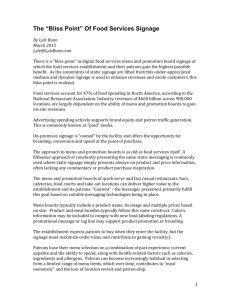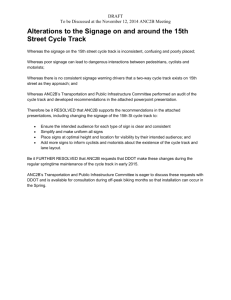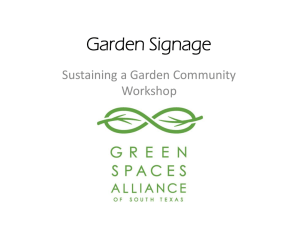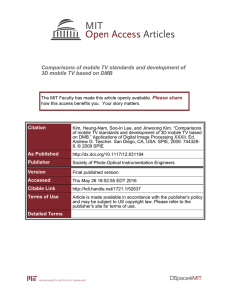Digital Menu Boards: Moving the Needle on Food
advertisement
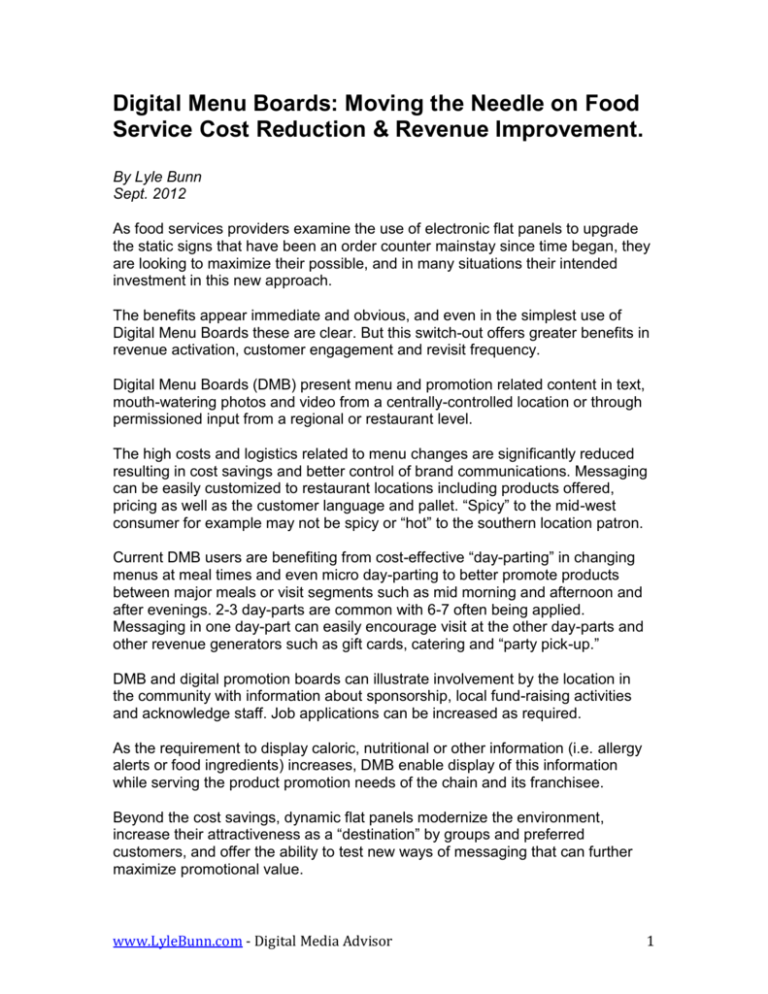
Digital Menu Boards: Moving the Needle on Food Service Cost Reduction & Revenue Improvement. By Lyle Bunn Sept. 2012 As food services providers examine the use of electronic flat panels to upgrade the static signs that have been an order counter mainstay since time began, they are looking to maximize their possible, and in many situations their intended investment in this new approach. The benefits appear immediate and obvious, and even in the simplest use of Digital Menu Boards these are clear. But this switch-out offers greater benefits in revenue activation, customer engagement and revisit frequency. Digital Menu Boards (DMB) present menu and promotion related content in text, mouth-watering photos and video from a centrally-controlled location or through permissioned input from a regional or restaurant level. The high costs and logistics related to menu changes are significantly reduced resulting in cost savings and better control of brand communications. Messaging can be easily customized to restaurant locations including products offered, pricing as well as the customer language and pallet. “Spicy” to the mid-west consumer for example may not be spicy or “hot” to the southern location patron. Current DMB users are benefiting from cost-effective “day-parting” in changing menus at meal times and even micro day-parting to better promote products between major meals or visit segments such as mid morning and afternoon and after evenings. 2-3 day-parts are common with 6-7 often being applied. Messaging in one day-part can easily encourage visit at the other day-parts and other revenue generators such as gift cards, catering and “party pick-up.” DMB and digital promotion boards can illustrate involvement by the location in the community with information about sponsorship, local fund-raising activities and acknowledge staff. Job applications can be increased as required. As the requirement to display caloric, nutritional or other information (i.e. allergy alerts or food ingredients) increases, DMB enable display of this information while serving the product promotion needs of the chain and its franchisee. Beyond the cost savings, dynamic flat panels modernize the environment, increase their attractiveness as a “destination” by groups and preferred customers, and offer the ability to test new ways of messaging that can further maximize promotional value. www.LyleBunn.com - Digital Media Advisor 1 Great value in “moving the needle” comes when the DMB is used as a tool for merchandising, promotion and ambiance. The Tim Horton chain of coffee shop, pastry, soup and sandwich locations is moving to a complete DMB after realizing significant benefits from a single panel in the middle in static board that sought to upsell and increase visit frequency. The Playloop comprised of 5-10 messages corresponded in length to the one minute or so order line wait period. “Tim’s” has successfully introduced new menu items and accelerated these revenues as has McDonald’s in their introduction of the McCafe beverage line. Others are enjoying extraordinary value through their innovative use of the medium and other food services providers including quick-serve, fast casual and cafeteria are moving forward in their use of this proven medium for the cost savings, greater revenues, reduced perceived wait times, flexibility and ambiance offered by electronic digital displays. They realize that consumer are seeing these displays in many other locations including stores, transit, workplace, schools and competitor locations and are actively pursuing dynamic media as a display option. As they move forward, they are realizing that a suitable technology infrastructure including the flat panel, media player, connectivity and Content Management Software and other elements must serve their immediate needs while also being “future-proofed” to assure ongoing value as the way in which they use this powerful media evolves. As large food services providers seek to establish a corporate approach, often replacing or trying to leverage initiatives that have been undertaken by operating managers or franchisees, there are particular challenges. Nobody wants to lose the value from past investment, yet want to take advantage of improved approaches that could be available. Independent, external counsel can help in plans to define the optimal technology, re-purpose existing infrastructure and define the best approaches to achieving goals at multiple organizational levels. Following 5 tips will help food service providers to minimize the time and investment needed to implement and use the medium while assuring maximum return over time. 1. Focus on upsell, cross-sell and revisits. All elements of the dynamic signage must focus on achieving the fundamental goal of merchandising and promotion for revenue achievement. While compliance to regulations (such as posting nutritional/caloric information) and other benefits can be realized, the use and optimization of the medium must be on maximizing the customers’ intention of spending, eating and enjoying – to the benefit of the establishment as well. www.LyleBunn.com - Digital Media Advisor 2 2. Involve the Team and optimize. Customer facing dynamic signage effects all elements of the business including marketing, store operations, customer experience, purchasing, information technology, human resources, venue design and other operations as well as franchisees, suppliers, partners and others. Each part of the organization will have its unique input to making the best use of the new signage. Under strong project leadership, inputs should be welcomed on an ongoing basis so as to optimize the value and benefits, while assuring that the dynamic signage fits within an overview intention of customer experience while maximizing revenues. Stakeholders should provide performance indicators based on their area of greatest need and concern, and based on these can provide useful analytics and metrics about the signage performance along with possible ways of improving the benefits received. 3. Software makes in-store media happen. More than 250 different Content Management Software systems exist, each offering different benefits and approaches but these generally fit into 2 major categories. Some systems simply publish images in the way that powerpoint can present slides on a timer. When selecting software, assure that maximum flexibility and capability is available in order to assure that ongoing operation costs are minimized and the software will not limit the way that sign can provide value. Many assessment criteria can apply to software selection, and these are important inputs to the selection decision. 4. Commercial versus Consumer or “Pro-sumer” grades of technologies. Digital signage operation in a food service facility can be very demanding due to long hours of daily use, heat, and airborne particles. Technology elements such as the media player and display need to be able to withstand long “duty cycles” of flawless operation in presenting the content that will deliver business value. In doing so, the “total cost of ownership” will consider warranty and replacement, redundancy and the ability to monitor and calibrate signage performance. 5. Start how you plan to finish. While starting with even a single flat panel is useful to working through content approaches, integration into the environment and assessing impact, the project should been planned with the ability to phasein new elements. Defining the likely future usage scenario assures that the initial investment is best made while providing the ability to scale the project as greater benefit can be achieved. In starting by identifying possible best uses and integration with other communications, customer engagement and operational elements, the initiative can get started while moving continuously to improve the way that the displays are used and how they achieve intended goals. www.LyleBunn.com - Digital Media Advisor 3 A number of future use scenarios should be considered in the DMB and promotion board design. Some of these include: On system message authoring / composition and dynamic content production. New approaches to display beyond the Digital Menu Board (i.e. at tables). Integration with data feeds/sources such as weather, notifications, socioeconomic targeting, event calendars, etc. Integration with Anonymous Viewer Analytics and Sentiment Analysis for the gathering of consumer insights or dynamic message provisioning. Integration with cell phones and mobile devices. More local or regional input or control. (i.e. community support initiatives, other nearby locations, upcoming promotions). Changes in the menu presentation approach including better and more extensive use of motion “visuals” and images and better audience targeting. More suggestive selling including order combinations. Use of the DMB and panels for order pick-up notification. Integration with social media and other “earned” media approaches. Support for more interaction between patrons and social engagement on premises. (i.e. gaming, trivia contest, etc.). Presentation of in-restaurant images of or by patrons. (i.e. a Disney restaurant adds photos of guests noting their occasion with permission). Gaining and/or presenting customer feedback. Food Service and digital messaging technologies are a natural combination, as is being seen from the explosive growth in the use of this medium. While even skillful use of the simplest approaches can deliver cost savings and increased revenue, the greater value of the investment is achieved through planning at the beginning of the investment process. More information about this medium is available in the “SPEED” digital signage training program which has been used by over 2500 professionals and is available online at www.DSEG.org. The “desktop” course addresses how to plan, source, operate and benefit from the medium. About the author: Lyle Bunn (Ph.D. Hon) is considered North America’s “number 1” dynamic signage industry consultants. He has assisted hundreds of organizations in their project planning and optimization, has trained several thousands professionals and published over 200 articles and whitepapers related to the medium over his 10 years in the industry. See www.LyleBunn.com for more resources or contact Lyle@LyleBunn.com. www.LyleBunn.com - Digital Media Advisor 4

